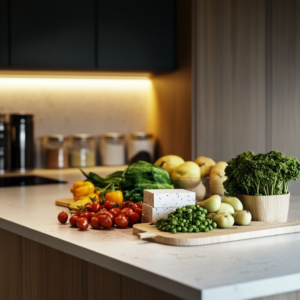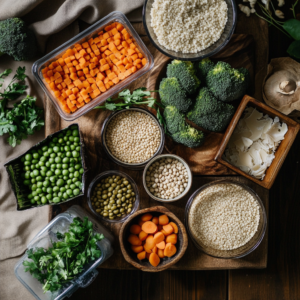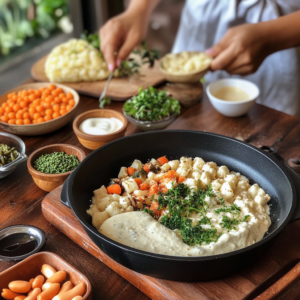Introduction
Weeknights can be hectic. Perhaps you juggle a demanding job, schoolwork, family obligations, or all the above. At times, investing hours in the kitchen simply isn’t feasible, yet you still desire nutritious, tasty meals that honor a plant-based lifestyle. That’s exactly why quick and delicious vegan recipes stand out—they marry the convenience of short prep times with the health and satisfaction of a well-rounded vegan approach. In this guide, I’ll share my tried-and-true strategies, pantry essentials, cooking techniques, and a handful of reliable recipes that can be on the table in 30 minutes or less. By integrating these ideas into your routine, you’ll see how effortless it is to create flavorful, balanced dinners during even the busiest weeknights. If you’re concerned about costs, check Budget-Friendly Vegan Meals That Don’t Sacrifice Taste. And if you’re intrigued by seasonal produce, take a look at Seasonal Vegan Recipes: Fresh Ideas for Every Season. Let’s get started.

The Importance of Quick Vegan Recipes
Why Speed Matters in a Busy Lifestyle
Sometimes, lack of time is the largest barrier that people cite when adopting or maintaining a vegan regimen. After all, illusions of elaborate prep and complicated recipes can scare novices away. However, “quick” doesn’t mean inadequate. By focusing on ingredients that cook rapidly—like extra-firm tofu, canned beans, frozen vegetables—and deploying simple cooking methods, you can have a well-rounded plate ready before your doorbell rings for a delivery. For individuals juggling late work hours, after-school programs, or personal commitments, a 20-30 minute meal can mean the difference between staying healthy or relying on highly processed convenience foods.
Nutritional Value Without Compromise
Short cooking times often safeguard more vitamins and minerals, preventing nutrient loss that can accompany longer simmering. Legumes, greens, and colorful veggies remain crisp and nutrient-dense if sautéed or stir-fried quickly. Quick recipes can also incorporate balanced macros—protein from legumes or tofu, healthy fats from seeds or avocado, and energizing carbs from whole grains. The result is a dish loaded with fiber, vitamins, antioxidants, and protein, perfect for fueling your busy schedule. For more on basic vegan nutrition, see Understanding Vegan Nutrition: What Every Beginner Should Know.
Key Takeaways
- Cooking in under 30 minutes is fully achievable with strategic ingredient choices and simple methods.
- Speed need not compromise nutrition or taste, especially if you’re mindful about macros and produce.
- Frozen or canned staples can be lifesavers on busy weeknights, reducing chopping and pre-cooking times.
Essential Ingredients and Kitchen Tools
Stocking a Vegan-Friendly Pantry
An efficient pantry is foundational to any quick-cooking routine. Keep a variety of canned beans—like black beans, chickpeas, pinto beans—on standby for instant protein. Whole grains such as quinoa, brown rice, and even quick-cook options like couscous or bulgur expedite mealtime. Frozen vegetables, including broccoli florets or stir-fry mixes, bypass the hassle of chopping fresh produce while preserving nutrients. Add flavor enhancers like soy sauce or tamari, sriracha, nutritional yeast, spices, and herbs. Having these on hand drastically reduces the mental load around mealtime decisions.
Must-Have Cooking Equipment
- Non-Stick Skillet or Wok: Perfect for quick stir-fries and sautéing with minimal oil.
- Medium or Large Saucepan: For soups, grains, or quick one-pot pasta.
- Instant Pot or Pressure Cooker: If you’re into dried legumes or want even faster cooking.
- Quality Knife: Streamlines chopping, particularly important if you have minimal prep time.
- Blender or Food Processor: For swift sauces, dips, or soups.
By combining these tools with your curated pantry, you eliminate guesswork and expedite meal prep. For further pointers on essential kitchen gear, see Mastering Vegan Cooking: Top Tips for Beginners.
Key Takeaways
- A stocked pantry prevents mid-week cooking dread and temptation to order takeout.
- Basic equipment—like a non-stick skillet—speeds up cooking and cleans easily.
- Frozen veggies, canned beans, and quick-cooking grains are the holy trinity of weeknight convenience.

Fast Vegan Cooking Techniques
Stir-Fry and Sauté Methods
Stir-frying is a champion of quick vegan cooking. By heating a small amount of oil or broth in a pan and tossing in vegetables and proteins at high heat, you seal in flavor while preserving some crispness. Tofu, tempeh, or seitan can be pan-fried in under 10 minutes if cut into small cubes or strips. Meanwhile, pre-washed or frozen vegetables reduce prep time. A dash of soy sauce, ginger, or garlic completes a classic stir-fry experience. If you want more details on building balanced stir-fries, see How to Boost Your Energy with a Vegan Diet.
One-Pot and Sheet Pan Meals
One-pot wonders are ideal for those disinclined to wash multiple pans. Think of a simple pasta dish: sauté onion and garlic, add tomatoes or sauce, throw in lentils or beans plus your choice of pasta, and cook it all together. This method saves big on cleanup. Sheet pan meals similarly allow you to place marinated tofu, chopped veggies, and seasonings on a single tray, roasting them simultaneously. This approach uses oven time instead of your direct involvement, letting you multi-task around the house.
Leveraging Pressure Cookers or Instant Pots
For dried beans or lentils, a pressure cooker can cut cooking times drastically—chickpeas that might take an hour on the stovetop could be tender in 15-20 minutes under pressure. Even if you prefer fresh produce, you might sauté onions in the pot, then toss in your grains and legumes, set it, and walk away. Perfect for those who cannot babysit the stove but want a home-cooked dinner quickly.
Key Takeaways
- Stir-frying at high heat preserves color, texture, and can be done in 15 minutes.
- One-pot or sheet pan dishes condense cooking tasks into single steps.
- Pressure cookers make bean-based meals practical for weeknights, delivering from-scratch taste in minimal time.
Building Balanced Quick Meals
Prioritizing Protein, Fats, and Carbs
A balanced meal often has a protein anchor (tofu, tempeh, beans), a source of healthy fats (avocado, seeds), and a carbohydrate (brown rice, quinoa, whole wheat pasta). This trifecta supplies stable energy, builds and repairs tissues, and boosts nutrient absorption. If a meal lacks one of these components, you can quickly adjust—like adding pumpkin seeds or walnuts for extra protein and fat, or throwing in a handful of spinach for added micronutrients.
Ensuring Micronutrient Coverage
Short cooking times can actually preserve more water-soluble vitamins in produce. Veggies only need a few minutes to crisp up in a stir-fry or partial sauté. Add a splash of lemon juice at the end for vitamin C, or sprinkle in nutritional yeast for B vitamins. Combining variety across the week ensures you get an array of essential vitamins and minerals. For more in-depth nutritional structure, see 10 Essential Vegan Nutrition Tips for a Healthier Life.
Key Takeaways
- Aim for a protein, healthy fat, and complex carb in each quick meal.
- A bit of citrus or vinegar at the end can enliven flavors and help with certain nutrient absorption.
- Rotating vegetables and grains day-to-day promotes broad micronutrient intake.

Five Go-To Quick Vegan Recipes for Weeknights
Recipe 1: 15-Minute Colorful Stir-Fry
Ingredients
• 1 cup extra-firm tofu, cubed
• 2 cups mixed vegetables (broccoli, bell peppers, carrots, zucchini)
• 1 tablespoon low-sodium soy sauce or tamari
• 1 teaspoon garlic, minced
• 1 teaspoon ginger, minced
• 1 tablespoon neutral oil or vegetable broth for sautéing
Instructions
- Preheat a non-stick pan on medium-high.
- Add oil or broth, garlic, ginger. Stir until fragrant.
- Drop in tofu cubes, cooking until golden on some sides.
- Toss in vegetables, stir-frying for 4-5 minutes.
- Season with soy sauce or tamari.
- Serve over brown rice.
Approx Time: ~15 minutes
Recipe 2: Creamy One-Pot Pasta
Ingredients
• 8 ounces whole wheat pasta
• 2 cups vegetable broth
• 1/2 cup plant-based milk (soy, almond)
• 1/2 cup chopped spinach or kale
• 2 tablespoons nutritional yeast
• Garlic powder, onion powder, salt, pepper to taste
Instructions
- Combine pasta, broth, and plant-based milk in a large saucepan.
- Season with garlic powder, onion powder, salt, and pepper.
- Bring to a boil, then reduce heat and stir occasionally for ~10 minutes.
- Stir in spinach/kale and nutritional yeast once pasta is nearly cooked.
- Adjust seasonings, garnish with fresh herbs if desired.
Approx Time: ~15 minutes
Recipe 3: Spicy Chickpea Lettuce Wraps
Ingredients
• 1 can of chickpeas, drained
• 2 tablespoons tahini or hummus
• 1 teaspoon chili flakes or hot sauce (optional)
• A handful of lettuce leaves (romaine or iceberg)
• 1 small cucumber, diced
• Salt, pepper to taste
Instructions
- Mash chickpeas with tahini/hummus, stirring in chili flakes if you want heat.
- Season with salt, pepper.
- Spoon mixture onto lettuce leaves.
- Top with diced cucumber or any fresh veggies.
- Roll or fold and enjoy.
Approx Time: ~10 minutes
Recipe 4: Veggie-Loaded Quesadillas
Ingredients
• 2 whole wheat tortillas
• 1/2 cup mashed black beans
• 1/2 cup chopped veggies (onions, peppers, spinach)
• 2 tablespoons nutritional yeast (optional)
• 1 tablespoon oil or cooking spray
Instructions
- Heat a pan over medium.
- Spread mashed black beans on one tortilla.
- Scatter chopped veggies and sprinkle nutritional yeast if desired.
- Place the second tortilla on top, pressing gently.
- Lightly oil the pan, cook the quesadilla ~2-3 minutes per side until lightly browned.
- Slice into quarters and serve with salsa or guacamole.
Approx Time: ~15 minutes
Recipe 5: Curried Lentil Soup
Ingredients
• 1 cup red lentils (they cook faster)
• 3 cups vegetable broth
• 1/2 onion, chopped
• 1 medium carrot, chopped
• 1 tablespoon curry powder
• Salt, pepper to taste
Instructions
- Sauté onion and carrot in a small pot with minimal oil or broth.
- Add lentils, broth, and curry powder.
- Bring to a boil, then reduce heat and simmer about 15 minutes.
- Season, adjust thickness with water or broth if needed.
- Serve with bread or a side of brown rice.
Approx Time: ~20 minutes
Meal Prep for Even Faster Nights
Pre-Cooking Grains and Proteins
Cooking large batches of brown rice, quinoa, or whole wheat pasta can drastically slash dinner prep. Keep them in the fridge, and pair with quickly sautéed tofu or a can of beans. That might transform your evening from a frantic scramble to a calm 10-minute assembly. For added tips on meal prep, see Vegan Meal Prep Ideas to Simplify Your Week.
Pre-Cut Vegetables and Ready Sauces
If you spare 30 minutes on Sunday to wash and chop onions, bell peppers, or carrots, you can store them in containers for instant use in stir-fries or soups. Quick sauces like a peanut-ginger blend or tahini dressing keep in jars up to a week. This way, your nightly “cooking” is limited to heating pre-cooked grains, tossing in pre-cut veggies, adding a protein, and finishing with a homemade sauce.
Key Takeaways
- An hour of prep earlier in the week can save significant daily mealtime stress.
- Pre-cooked grains, chopped veggies, and small-batch sauces let you assemble full dinners in 15 minutes.
- Organized storage is key—label containers to avoid confusion.
Flavor Boosters and Variety
Rotating Spices and Herbs
One straightforward way to keep quick dinners interesting is frequently changing your seasonings. If Monday’s tofu uses an Italian herb blend, Tuesday’s can feature Cajun spice, and Wednesday’s might pivot to curry powder. This approach transforms the same staple ingredients, preventing boredom without extending cooking times.
Quick Sauces and Toppings
• Tahini-Lemon: Blend tahini, lemon juice, garlic powder, salt, pepper, water for thinning
• Peanut-Ginger: Mix peanut butter, soy sauce, grated ginger, a bit of sugar or sweetener, and water
• Maple-Dijon: Whisk Dijon mustard with maple syrup, a pinch of salt, and some vinegar
Even minimal additions—like a drizzle of chili oil or sprinkling of nutritional yeast—can enhance your meal. If your aim is to keep sugar and salt moderate, choose low-sodium soy sauce or homemade alternatives.
Key Takeaways
- Frequent spice/herb rotations recast the same fundamental vegetables or proteins into distinct dishes.
- Simple sauces build big flavor with minimal prep time.
- A few go-to condiments or dressings, stored in the fridge, can cut daily meal assembly to a fraction.
Overcoming Common Obstacles
Limited Time and Budget
Cooking fast can appear to call for high-end convenience foods. In reality, you can leverage budget-friendly staples—like dry beans or oats—and use quick-cook versions (e.g., bulgur or couscous) to maintain low costs. If you have time on weekends, cooking big batches of legumes from dried form with a pressure cooker can reduce the cost per serving even more. For in-depth financial tips, see Budget-Friendly Vegan Meals That Don’t Sacrifice Taste.
Cooking for Non-Vegans or Mixed Households
When living with family or roommates who are not vegan, try focusing on meals that are easily adaptable. For instance, you can cook a base of stir-fried veggies and grains, then let people top with their protein preference. Alternatively, add robust seasonings or sauces that have universal appeal, so no one feels like they’re missing out.
Key Takeaways
- Lean on cost-efficient goods and partial meal prep to keep quick recipes wallet-friendly.
- Modular recipes let non-vegans customize their plates while you stick to purely plant-based items.
- Embrace simple flavor twists—like miso, sriracha, or curry—to appeal widely.
External References for Inspiration
YouTube Tutorials and Official Health Sites
For quick recipes, I love searching for short step-by-step videos on YouTube. Channels like NutritionFacts.org or major vegan cooks show thorough how-to’s. Meanwhile, official bodies like the USDA or the Academy of Nutrition and Dietetics have position statements on vegetarian or vegan diets that confirm the feasibility of meeting all nutrient needs with plant foods (1). Combining these two resources can give you both the “how” (recipe instructions) and the “why” (scientific backing).
Key Takeaways
- Brief cooking videos visually demonstrate time-saving hacks.
- Official guidelines help confirm you are fulfilling recommended daily nutrients.
- Cross-reference information for accuracy and relevance to your personal routine.
Affiliate Product Recommendations (CTAs)
If you want to learn several recipes for delicious vegan dishes, I recommend this cookbook that was useful to me and I would like to share it with you.
Conclusion
Creating quick and delicious vegan meals for busy weeknights isn’t only possible—it’s an enjoyable craft. By keeping a well-stocked pantry, leveraging shortcuts like canned legumes or frozen veggies, and employing fast-cooking techniques such as stir-frying, you’ll effortlessly combine convenience with nourishment. Small meal preps, flexible recipes, and bold flavor boosters ensure variety. Over time, you’ll find the “quick meal” mindset second nature, enabling you to consistently deliver balanced, plant-based dinners in mere minutes. For more structured cooking help, visit Mastering Vegan Cooking: Top Tips for Beginners.
FAQ (Frequently Asked Questions)
Q1: Are Quick Vegan Meals Healthy Enough?
Absolutely. With simple planning—like combining a protein source (beans, tofu), healthy fats (avocado, nuts), and a whole grain or veggie base—you can cover essential nutrients. The key is variety and stocking up on speedy ingredients.
Q2: Can I Rely on Frozen Veggies?
Yes. Frozen vegetables are flash-frozen at peak freshness, often retaining nutrients well. They also cut chopping time drastically. Aim for plain versions without added sauces or sodium.
Q3: How Do I Spice Up My Quick Meals Without Extra Cooking Time?
Sauces are your secret weapon. A drizzle of tahini-lemon, peanut-ginger, or miso-maple can elevate a basic stir-fry or bowl. Also keep diverse spice mixes (chili powder, garam masala) on hand for instant flavor changes.
Q4: What If My Family Eats Meat—Will They Accept These Vegan Quick Meals?
Many quickly discover that well-seasoned, tasty plant-based dinners appeal widely. You can offer an optional topping (like shredded cheese or a meat side) if they are not fully on board, but a good sauce or marinade often wins over skeptics.
Q5: Is It Cheaper or More Expensive to Cook Vegan Rapidly?
It can be very budget-friendly. Staples like beans, grains, and seasonal veggies are among the least expensive grocery items. Buying dried beans in bulk and cooking them in a pressure cooker amplifies savings. For extra advice, check Budget-Friendly Vegan Meals That Don’t Sacrifice Taste.